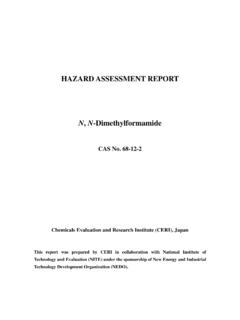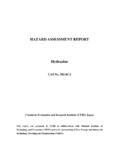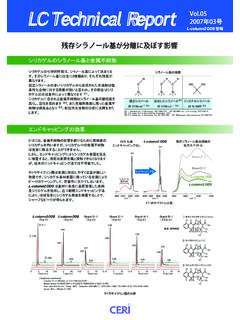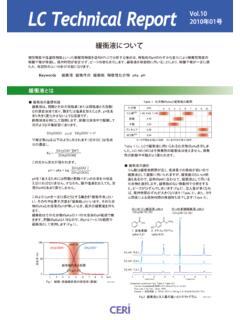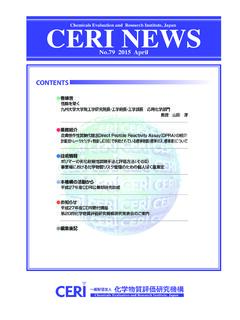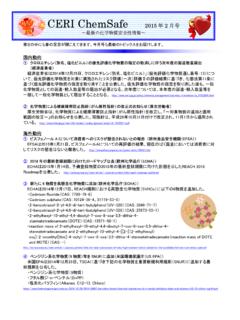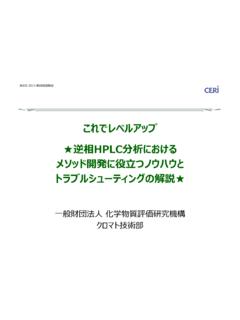Transcription of HAZARD ASSESSMENT REPORT 3,3’-Dichloro-4,4 ...
1 HAZARD ASSESSMENT REPORT 3,3 -Dichloro-4,4 -diaminodiphenylmethane CAS No. 101-14-4 Chemicals Evaluation and Research Institute (CERI), Japan This REPORT is prepared by CERI in collaboration with National Institute of Technology and Evaluation (NITE) under the sponsorship of New Energy and Industrial Technology Development Organization (NEDO). ii Preface to the English Version of the HAZARD ASSESSMENT Reports For six years from April 2001 to March 2007, Chemicals Evaluation and Research Institute (CERI/Japan) was engaged in a project named Chemical Risk ASSESSMENT and Development of Risk ASSESSMENT Methods under "Comprehensive Chemical Substance ASSESSMENT and Management Program" funded by New Energy and Industrial Technology Development Organization (NEDO/Japan). Under this project, about 150 chemical substances were selected among those designated as Class-I Chemicals in the Law for Pollutant Release and Transfer Register and Promotion of Chemical Management (hereafter PRTR Law)1).
2 The selection criteria of these chemicals were their priorities for risk ASSESSMENT based on their production levels and environmental/human health concerns. CERI developed the HAZARD ASSESSMENT reports of these selected chemical substances based on the review and evaluation of the environmental and human health HAZARD data obtained from the existing evaluation documents released by the regulatory agencies and international organizations as well as those from the published scientific literatures. The data review and compilation of the reports were conducted according to the guidelines2) and the guidance manual2) developed for this project. The proposed HAZARD ASSESSMENT reports by CERI were reviewed by the experts in the relevant scientific fields from both inside and outside this project for accuracy, relevance and completeness.
3 The final reports were published in Japanese after going through the deliberation by the Council on Chemical Substances under the Ministry of Economy, Trade and Industry (METI/Japan), which is responsible for regulation of chemical substances in Japan. This project was the first attempt in Japan to develop comprehensive HAZARD assessments of chemical substances for application in risk ASSESSMENT . In order to share the outcomes of the project globally, CERI independently selected the following seven chemical substances and developed the English version of the HAZARD ASSESSMENT reports: (1) Acetaldehyde (2) Chlorobenzene (3) Hydrazine (4) N, N-Dimethylformamide (5) Poly(oxyethylene)nonylphenylether (6) 3,3 -Dichloro-4,4 -diaminodiphenylmethane (7) Dimethyl-2,2-dichlorovinyl phosphate (Dichlorvos) We hope that the HAZARD ASSESSMENT reports from our project contribute to the risk ASSESSMENT and management of chemical substances globally, and appreciate your feedback.
4 1) Details of the PRTR Law, the list of designated chemical substances, and release data in Japan are available on Internet at: 2) Guidelines and the guidance manual in Japanese are available on Internet at: Also, the initial risk ASSESSMENT reports in Japanese developed in this project which include calculations of margin of exposure based on the result of HAZARD ASSESSMENT and exposure ASSESSMENT , are available on Internet at: iii Date: May, 2007 Chemicals Evaluation and Research Institute 1-4-25 Koraku, Bunkyo-ku, Tokyo 112-0004, Japan iv Summary 3,3 -Dichloro-4,4 -diaminodiphenylmethane (MBOCA) is a colorless crystal or light brown pellet having a melting point of 110 C and a vapor pressure of Pa at 60 C. It has water solubility of mg/L at 24 C and is soluble in organic solvents including dichloromethane, acetonitrile and acetone.
5 MBOCA is mainly used as a hardner of urethane resin for waterproof, flooring and all-weather pavement materials. Domestic production of MBOCA was 4,000 tons per year for 5 years from 1997 to 2001 in Japan. Considering the uses of MBOCA and annual emission data for fiscal year 2001 in Japan (the 2001 PRTR data), the main release route is through the use of MBOCA or products containing MBOCA. As the senario of MBOCA releases in Japan, it has been estimated that 201 kg was annually released into air and 30 kg into water. MBOCA released into the aquatic environment is adsorbed to suspended solids in water and transferred to sludge. It is assumed that MBOCA is rarely volatilized from water into the air. However, in a specific condition of assimatization of activated sludge, MBOCA can be eliminated by biodegradation.
6 Low bioaccumulation is suggested in aquatic orgainisms. Many studies have been conducted to assess toxic effects of MBOCA on organisms in the environment using indices including mortality, immobilization and growth inhibition. In a growth inhibition study of MBOCA in freshwater alga, the 96-hr EC50 was mg/L in biomass for the alga. The NOEC for the alga was mg/L in biomass and mg/L in growth rate. The acute toxicity of MBOCA to invertebrates is reported in freshwater water flea. The 48-hr EC50 (immobilization) was mg/L. The long-term toxicity of MBOCA is reported in a reproductivity study of the water flea. The 21-day NOEC was mg/L with the endpoints of effects on reproduction and parent lethality. The acute toxicity of MBOCA to fish is reported in Japanese killifish. The 96-hr LC50 is mg/L. No reports on long-term toxicity of MBOCA to fish were obtained in this investigation.
7 The lowest value of toxicity in aquatic organisms is mg/L as the 21-day NOEC for reproduction and parent lethality in crustacean water flea. In an oral administration study of MBOCA to rats, MBOCA is distributed in the liver, adipose tissue, kidney and small intestine at 48 hours after administration. MBOCA is metabolized by cytochrome P450 to form N-hydroxy-MBOCA in humans, rats and guinea pigs, but o-hydroxy-MBOCA in dogs. These metabolites are further metabolized into glucuronoconjugates and sulfoconjugates and excreted in urine. Unchanged MBOCA was detected in the urine of humans and rats to lesser extent. Over 60% of given dose was excreted in feces, 20 to 40% in vurine by 48 hours after administration. MBOCA was also excreted in bile. In human studies, two accidental cases have been reported.
8 A person who was exposed to melted MBOCA in the face complained conjunctivitis, pain in the eyes and face and nausea and showed transient renal dysfunction. Another person who received melted MBOCA on the upper body, arms and legs had moderate inflammation in the arm but showed no methemoglobinemia, hematuria or proteinuria. In this case, DNA adduct of N-hydroxy-MBOCA was observed in the urothelial cells collected over time from the urine until 98 hours after exposure. In an epidemiological study for the workers who were engaged in MBOCA production, the possibility that MBOCA induced bladder tumors in humans was suggested, although there was no sufficient evidence. In experimental animals, for the acute toxicity of MBOCA, the oral LD50 values ranged from 640 to 880 mg/kg in mice, 750 to 2,100 mg/kg in rats and 400 mg/kg in guinea pigs.
9 The percutaneous LD50 was over 5,000 mg/kg in rabbits. As acute toxicity symptoms of MBOCA, ataxia and cyanosis were observed in rats and rabbits. MBOCA exhibited very slight irritation to the skin of guinea pigs and slight irritation to the conjunctiva of rabbits. MBOCA exhibited no skin sensitization in guinea pigs. The oral (gavage) repeated administration of MBOCA for ten days caused cyanosis, depression in body weight gain, methemoglobinemia, pallor, weakness and polyuria and death. Percutaneous administration of MBOCA to rabbits for 2 weeks resulted in cyanosis, pallor, slight cyanosis and hematuria in the first week. In the second week, a rabbit showed cyanosis only. However, no appropriate data to establish the NOAEL were obtained in this investigation. No reports on reproductive and developmental toxicity of MBOCA were obtained in this investigation.
10 In genotoxicity studies, MBOCA showed positive responses in reverse mutation assays using bacteria, and in gene mutation, chromosomal aberration and DNA damage tests using mammalian cultured cells in in vitro studies. In addition, MBOCA showed positive responses in cell transformation assays using cultured cells. MBOCA induced somatic mutation, chromosomal aberration, increases in SCE of the peripheral lymphocytes and DNA adduct of N-hydroxy-MBOCA in the urothelial cells in experimental animals in in vivo studies. From the overall evaluation of these data, MBOCA is considered to be genotoxic. In carcinogenicity studies, oral administration of MBOCA induced hepatocellular carcinoma in mice, lung tumor, mammary adenocarcinoma, Zymbal gland carcinoma, hepatocellular caricinoma and haemangiosarcoma in rats and bladder carcinoma in dogs.
